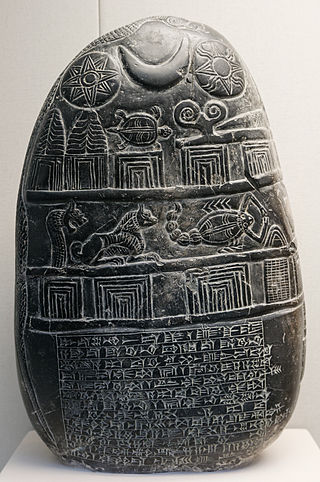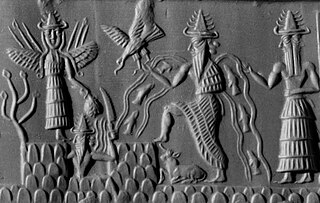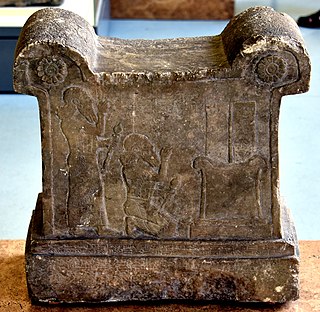Related Research Articles

Nergal was a Mesopotamian god worshiped through all periods of Mesopotamian history, from Early Dynastic to Neo-Babylonian times, with a few attestations under indicating his cult survived into the period of Achaemenid domination. He was primarily associated with war, death, and disease and has been described as the "god of inflicted death." He reigned over Kur, the Mesopotamian underworld, depending on the myth either on behalf of his parents Enlil and Ninlil, or in later periods as a result of his marriage with the goddess Ereshkigal. Originally either Mammitum, a goddess possibly connected to frost, or Laṣ, sometimes assumed to be a minor medicine goddess, were regarded as his wife, though other traditions existed, too.
Nammu was a Mesopotamian goddess regarded as a creator deity in the local theology of Eridu. It is assumed that she was associated with water. She is also well attested in connection with incantations and apotropaic magic. She was regarded as the mother of Enki, and in a single inscription she appears as the wife of Anu, but it is assumed that she usually was not believed to have a spouse.

Ištaran was a Mesopotamian god who was the tutelary deity of the city of Der, a Sumerian city state positioned east of the Tigris on the border between Sumer and Elam. It is known that he was a judge deity, and his position in the Mesopotamian pantheon was most likely high, but much about his character remains uncertain. He was associated with snakes, especially with the snake god Nirah, and it is possible that he could be depicted in a partially or fully serpentine form himself.
Siris or Siraš was a Mesopotamian goddess associated with beer. She was also worshiped in Ebla, where her name was spelled as Zilaš. Cognates of her name are also present as terms referring to alcoholic beverages or deities associated with them in languages such as Ugaritic and Hebrew. She was closely associated with another goddess of similar character, Ninkasi, though the nature of the connection between them varies between sources. She is attested in a variety of texts, including god lists, offering lists and a variant of the Ballad of Early Rulers.

Ninshubur, also spelled Ninšubura, was a Mesopotamian goddess whose primary role was that of the sukkal of the goddess Inanna. While it is agreed that in this context Ninshubur was regarded as female, in other cases the deity was considered male, possibly due to syncretism with other divine messengers, such as Ilabrat. No certain information about her genealogy is present in any known sources, and she was typically regarded as unmarried. As a sukkal, she functioned both as a messenger deity and as an intercessor between other members of the pantheon and human petitioners.

Nirah was a Mesopotamian god who served as the messenger (šipru) of Ištaran, the god of Der. He was depicted in the form of a snake.
Ishum was a Mesopotamian god of Akkadian origin. He is best attested as a divine night watchman, tasked with protecting houses at night, but he was also associated with various underworld deities, especially Nergal and Shubula. He was associated with fire, but was not exclusively a fire god unlike Girra or Gibil. While he was not considered to be one of the major gods, he was commonly worshiped and appears in many theophoric names.

Isimud was a Mesopotamian god regarded as the divine attendant (sukkal) of the god Enki (Ea). He was depicted with two faces. No references to temples dedicated to him are known, though ritual texts indicate he was worshiped in Uruk and Babylon. He was also incorporated into Hurrian religion and Hittite religion. In myths, he appears in his traditional role as a servant of Enki.
Kakka was a Mesopotamian god best known as the sukkal of Anu and Anshar. His cult center was Maškan-šarrum, most likely located in the north of modern Iraq on the banks of the Tigris.
Tishpak (Tišpak) was a Mesopotamian god associated with the ancient city Eshnunna and its sphere of influence, located in the Diyala area of Iraq. He was primarily a war deity, but he was also associated with snakes, including the mythical mushussu and bashmu, and with kingship.

Anu or Anum, originally An, was the divine personification of the sky, King of the gods, and ancestor of many of the deities in ancient Mesopotamian religion. He was regarded as a source of both divine and human kingship, and opens the enumerations of deities in many Mesopotamian texts. At the same time, his role was largely passive, and he was not commonly worshiped. It is sometimes proposed that the Eanna temple located in Uruk originally belonged to him, rather than Inanna, but while he is well attested as one of its divine inhabitants, there is no evidence that the main deity of the temple ever changed, and Inanna was already associated with it in the earliest sources. After it declined, a new theological system developed in the same city under Seleucid rule, resulting in Anu being redefined as an active deity. As a result he was actively worshiped by inhabitants of the city in the final centuries of history of ancient Mesopotamia.

Nuska or Nusku, possibly also known as Našuḫ, was a Mesopotamian god best attested as the sukkal of Enlil. He was also associated with fire and light, and could be invoked as a protective deity against various demons, such as Lamashtu or gallu. His symbols included a staff, a lamp and a rooster. Various traditions existed regarding his genealogy, with some of them restricted to texts from specific cities. His wife was the goddess Sadarnunna, whose character is poorly known. He could be associated with the fire god Gibil, as well as with various courtiers of Enlil, such as Shuzianna and Ninimma.
Kanisurra was a Mesopotamian goddess who belonged to the entourage of Nanaya. Much about her character remains poorly understood, though it is known she was associated with love. Her name might be derived from the word ganzer, referring to the underworld or to its entrance. In addition to Nanaya, she could be associated with deities such as Gazbaba, Ishara and Uṣur-amāssu. She is first attested in sources from Uruk from the Ur III period, and continued to be worshiped in this city as late as in the Seleucid period.
An = Anum, also known as the Great God List, is the longest preserved Mesopotamian god list, a type of lexical list cataloging the deities worshiped in the Ancient Near East, chiefly in modern Iraq. While god lists are already known from the Early Dynastic period, An = Anum has most likely only been composed in the Kassite period.
Tadmuštum or Dadamušda was a Mesopotamian goddess associated with the underworld. She was regarded as the daughter of Nergal, and in known texts often appears in association with his main cult center, Kutha.
Sadarnunna was a Mesopotamian goddess regarded as the wife of Nuska. Very little is known about her individual character. She was worshiped in Nippur, and appears alongside other deities of this city in texts from the Ur III period already. In later times she is also attested in sources from other locations, for example Harran and Uruk.
Ara was a Mesopotamian goddess regarded as a servant of the god Enki. While in the past it was often assumed this theonym was only an alternate name Isimud, today the two are regarded as distinct deities who eventually came to be conflated with each other. Ara is attested in sources such as god lists, incantations and a curse formula from Malgium.
Latarak (Lātarāk) was a Mesopotamian god. He was most likely depicted as a figure clad in a lion's skin, or perhaps as a lion-like monster. He was regarded as a protective deity, invoked to defend doorways and ward off diseases. He was closely associated with Lulal, though the relationship between them varies between available primary sources, with some equating them and other treating them as a pair of similar, but not identical deities. He was worshiped in Mesopotamian cities such as Uruk, Nippur and Assur. It is also possible that a city named after him, Bāb-Lātarāk, existed, but the reading of this toponym is not certain. Outside Mesopotamia, he is attested in religious texts from Emar and in a trilingual god list from Ugarit.

Igalim or Igalimma was a Mesopotamian god from the local pantheon of the state of Lagash. He was closely associated with Ningirsu, possibly originating as the personification of the door of his temple, and was regarded as a member of his family. His older brother was Shulshaga and his mother was Bau, as already attested in Early Dynastic sources. Until the end of the Ur III period he was worshiped in Lagash and Girsu, where he had a temple, though he also appears in a number of later texts.
Kusibanda (Kusigbanda), also known under the disputed older reading of the name, Guškinbanda, was a Mesopotamian god regarded as the tutelary deity of goldsmiths and silversmiths. He was commonly grouped with other deities of similar character, such as Ninagal. He was also regarded as the husband of Ninimma, and was worshiped in her temple in Nippur. He is attested in texts describing the preparation of statues, as well as in a variety of documents from Uruk from the Seleucid period.
References
- 1 2 Taylor 2017, p. 123.
- 1 2 Rutherford 2017, p. 89.
- ↑ Wiggermann 1998, p. 217.
- 1 2 3 Wisnom 2020, p. 210.
- ↑ Smith 1994, p. 170.
- 1 2 3 4 5 6 Wiggermann 1998, p. 218.
- 1 2 3 4 Simons 2017, p. 89.
- 1 2 Taylor 2017, p. 126.
- ↑ Wiggermann 1998, pp. 217–218.
- 1 2 3 Taylor 2017, p. 125.
- ↑ Taylor 2017, p. 127.
- ↑ De Zorzi 2015, p. 254.
- ↑ Krul 2018, p. 185.
- ↑ Krul 2018, pp. 184–185.
- 1 2 Cavigneaux & Krebernik 1998, p. 486.
- ↑ Hunger & Pingree 1999, p. 60.
- ↑ Watson & Horowitz 2011, pp. 187–188.
- ↑ Hunger & Pingree 1999, p. 275.
- ↑ Hunger & Pingree 1999, p. 272.
- ↑ Simons 2017, p. 88.
- ↑ Tugendhaft 2016, p. 177.
- ↑ Lyons 1996, p. 90.
- 1 2 Taylor 2017, p. 124.
- ↑ Schwemer 2001, p. 346.
- ↑ Holloway 2002, p. 282.
- ↑ George 1992, p. 145.
- ↑ George 1992, p. 159.
- ↑ Weiershäuser & Novotny 2020, pp. 106–107.
- ↑ Weiershäuser & Novotny 2020, p. 108.
- ↑ George 1992, p. 245.
- ↑ Wisnom 2020, pp. 209–210.
- ↑ Zomer 2021, p. 324.
Bibliography
- Cavigneaux, Antoine; Krebernik, Manfred (1998), "dNin-SAR", Reallexikon der Assyriologie (in German), retrieved 2023-01-10
- De Zorzi, Nicla (2015). "Review: Erlend Gehlken: Weather Omens of Enūma Anu Enlil. Thunderstorms, Wind and Rain (Tablets 44–49)". Zeitschrift für Assyriologie und vorderasiatische Archäologie. Walter de Gruyter GmbH. 105 (2). doi:10.1515/za-2015-0020. ISSN 0084-5299.
- George, Andrew R. (1992). Babylonian Topographical Texts. Orientalia Lovaniensia analecta. Departement Oriëntalistiek. ISBN 978-90-6831-410-6 . Retrieved 2023-01-10.
- Holloway, Steven W. (2002). Aššur is king! Aššur is king! Religion in the exercise of power in the Neo-Assyrian Empire. Leiden: Brill. ISBN 1-4175-9092-0. OCLC 60245860.
- Hunger, Hermann; Pingree, David (1999). Astral sciences in Mesopotamia. Leiden. ISBN 978-90-04-29413-4. OCLC 944920350.
- Krul, Julia (2018). The Revival of the Anu Cult and the Nocturnal Fire Ceremony at Late Babylonian Uruk. Brill. doi:10.1163/9789004364943_004. ISBN 9789004364936.
- Lyons, Deborah (1996). Gender and Immortality. Princeton University Press. doi:10.1515/9781400864386. ISBN 978-1-4008-6438-6.
- Rutherford, Ian (2017). "Sandas in Translation". Hittitology today: Studies on Hittite and Neo-Hittite Anatolia in Honor of Emmanuel Laroche's 100th Birthday. ISBN 978-2-36245-083-9. OCLC 1286359422.
- Schwemer, Daniel (2001). Die Wettergottgestalten Mesopotamiens und Nordsyriens im Zeitalter der Keilschriftkulturen: Materialien und Studien nach den schriftlichen Quellen (in German). Wiesbaden: Harrassowitz. ISBN 978-3-447-04456-1. OCLC 48145544.
- Simons, Frank (2017). "A New Join to the Hurro-Akkadian Version of the Weidner God List from Emar (Msk 74.108a + Msk 74.158k)". Altorientalische Forschungen. De Gruyter. 44 (1). doi:10.1515/aofo-2017-0009. ISSN 2196-6761.
- Smith, Mark S. (1994). The Ugaritic Baal cycle. Volume I. Introduction with Text, Translations and Commentary of KTU 1.1-1.2. Leiden: Brill. ISBN 978-90-04-09995-1. OCLC 30914624.
- Taylor, Kynthia (2017). The Erra Song. A Religious, Literary, and Comparative Analysis (PDF) (PhD). Retrieved 2023-01-10.
- Tugendhaft, Aaron (2016). "Gods on clay: Ancient Near Eastern scholarly practices and the history of religions". In Grafton, Anthony; Most, Glenn W. (eds.). Canonical Texts and Scholarly Practices. Cambridge: Cambridge University Press. doi:10.1017/cbo9781316226728.009.
- Watson, Rita; Horowitz, Wayne (2011). Writing science before the Greeks: a naturalistic analysis of the Babylonian astronomical treatise MUL.APIN. Leiden: Brill. ISBN 978-90-04-20231-3. OCLC 727949975.
- Wisnom, Laura Selena (2020). Weapons of words. Intertextual competition in Babylonian poetry: a study of Anzū, Enūma eliš, and Erra and Išum. Leiden. ISBN 90-04-41297-2. OCLC 1120783834.
- Weiershäuser, Frauke; Novotny, Jamie (2020). The Royal Inscriptions of Amēl-Marduk (561–560 BC), Neriglissar (559–556 BC), and Nabonidus (555–539 BC), Kings of Babylon. Penn State University Press. doi:10.1515/9781646021178. ISBN 978-1-64602-117-8.
- Wiggermann, Frans A. M. (1998), "Nergal A. Philological", Reallexikon der Assyriologie, retrieved 2023-01-10
- Zomer, Elyze (2021). "Enmity Against Samsu-ditāna". Law and (Dis)Order in the Ancient Near East. Penn State University Press. doi:10.1515/9781646021208-028.